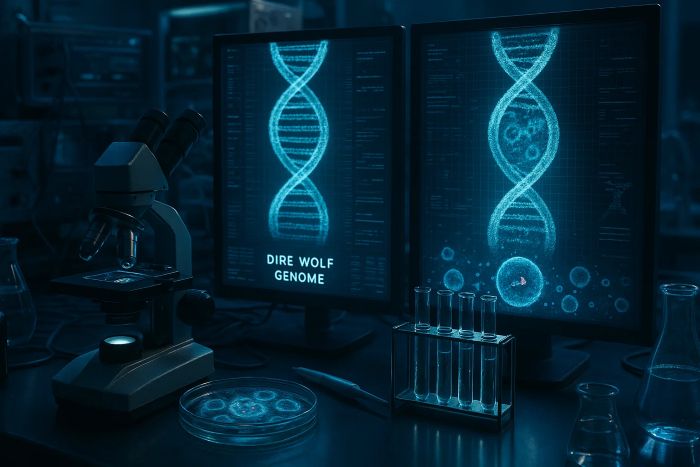Colossal Biosciences has achieved what many thought impossible: bringing back the dire wolf after 12,500 years of extinction. Their groundbreaking genetic resurrection method involved analyzing genomes from ancient dire wolf remains—specifically, a 13,000-year-old tooth and a 72,000-year-old skull—and identifying 20 key genetic differences across 14 genes that give dire wolves their distinctive traits.
These traits include the dire wolf’s larger size, white coat, wider head, larger teeth, more powerful shoulders, more muscular legs, and characteristic vocalizations like howling and whining.
The Colossal team harvested endothelial progenitor cells from living gray wolves – the dire wolf’s closest living relative – and edited the 14 genes to express the 20 dire wolf traits. This process required careful engineering to avoid unintended consequences, such as addressing genes that could potentially cause deafness or blindness.
After editing, the modified nuclei were inserted into denucleated gray wolf ova, which developed into embryos. These were then transferred to surrogate mother dogs – domestic hound mixes – resulting in the birth of three dire wolf pups: males Romulus and Remus (born October 2024) and female Khaleesi (born January 2025).
This achievement represents what Colossal CEO Ben Lamm calls “the first of many coming examples demonstrating that our end-to-end de-extinction technology stack works.” The company views this success as a critical step toward the de-extinction of other target species, including the woolly mammoth, dodo, and Tasmanian tiger.
The dire wolf resurrection process took just 18 months from start to finish, showcasing the efficiency of Colossal’s technological approach. As Lamm noted, “the only reason it was possible in 18 months is that we had the technology stack that we had been developing.”
The Technological Foundations
The genetic resurrection method employed by Colossal represents years of advances in multiple scientific fields converging into a single breakthrough application. The process begins with paleogenomic analysis, which involves extracting fragmented DNA from fossilized remains that are thousands of years old. These fragments must then be sequenced and assembled into a comprehensive genetic blueprint.
What makes Colossal’s approach particularly innovative is their non-invasive cell harvesting technique. Rather than requiring tissue samples from living gray wolves, which could be stressful for the animals, the team collected endothelial progenitor cells from the bloodstream. This minimally invasive procedure represents a significant advancement in genetic research methodology and demonstrates Colossal’s commitment to ethical practices.
The gene editing itself utilized CRISPR-Cas9 technology with proprietary modifications that increase precision and efficiency. This allowed the team to make multiple genetic edits while minimizing off-target effects that could potentially harm the resulting animals. Each modification was carefully tested in cell cultures before being implemented in the embryo creation process.
An often-overlooked aspect of the resurrection process is the role of computational modeling. Before any physical modifications were made, Colossal’s team created detailed simulations predicting how various genetic changes would affect the developing dire wolf embryos. These models helped identify potential issues early in the process and guided the selection of which genetic modifications to prioritize.
The resulting dire wolves serve as living proof of concept for Colossal’s de-extinction platform. While they represent the culmination of the current project, they also function as the foundation for future work. The knowledge gained from successfully resurrecting the dire wolf is already being applied to other de-extinction candidates and conservation efforts, creating a virtuous cycle of scientific advancement and environmental restoration.




